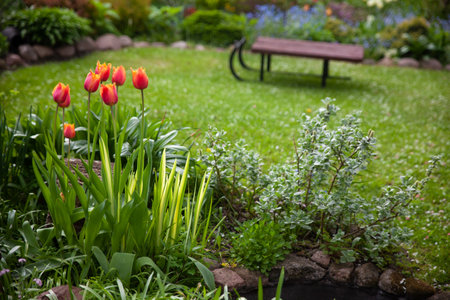Understanding Your Garden’s Microclimate
Every small UK garden is as unique as the families who tend to them. Before you even choose your first seed packet, take a moment to become a garden explorer with your children. Notice where the sunlight lingers longest—perhaps along a south-facing wall, or in that sheltered nook behind the shed. These warm spots can be perfect for growing sun-loving edibles like tomatoes and strawberries, while cooler, shady corners might suit leafy greens and herbs. Encourage your little ones to observe how morning dew settles or which areas dry out quickly after rain. By turning microclimate discovery into a shared adventure, you help children tune in to nature’s clues and learn how each patch of sunshine or shade can inspire new planting possibilities all year round. Let your family’s detective work spark conversations about weather, seasons, and plant needs—setting the stage for a thriving edible garden tailored to your own home’s mini-ecosystem.
2. Selecting Edible Plants for Every Season
When it comes to keeping your small British garden productive and inviting all year, choosing the right edible plants is essential. Think of your garden as a living calendar, where every season brings its own delicious highlight, ready to be enjoyed by the whole family. Whether you have a tiny courtyard or a cluster of pots on a balcony, there are plenty of compact yet bountiful options to try. Start by considering local climate conditions and the space available—many UK-friendly varieties thrive in containers or raised beds, making them perfect for modest plots.
Year-Round Edible Plant Choices
| Season | Edible Plant Ideas | Family Activity Inspiration |
|---|---|---|
| Winter | Kale, chard, winter purslane, purple sprouting broccoli | Bundle up together and pick hearty greens for warming soups. |
| Spring | Radishes, spring onions, salad leaves, broad beans | Sow seeds with little hands—watch them sprout as days grow longer. |
| Summer | Strawberries, dwarf tomatoes, courgettes, runner beans | Harvest juicy berries and veggies for picnics and playful taste tests. |
| Autumn | Beetroot, carrots, spinach, late raspberries | Dig together for hidden roots and celebrate with a homegrown feast. |
The Joy of Seasonal Tasting
Nurturing different crops each season not only maximises your small space but also sparks curiosity in children about where food comes from. The shifting tapestry of flavours—from the first crisp radish in spring to sweet autumn raspberries—offers endless opportunities for family connection and discovery. Let your garden reflect the rhythm of British seasons: resilient in winter, bursting in summer, always ready to surprise your senses.
![]()
3. Maximising Space: Raised Beds, Pots, and Vertical Solutions
Small UK gardens can become lush havens for year-round edible planting when we think creatively about the space we have. Whether you’re working with a tiny courtyard or a modest patio, there are clever ways to transform every nook into an edible paradise—and it’s even more fun when little ones get involved! Raised beds are a brilliant starting point; they help keep soil tidy and manageable while making it easier for small hands to help with planting and watering. Try dedicating one raised bed to salad leaves and another to root veggies, letting children choose their favourites to grow together.
Don’t overlook the power of pots and containers—these are perfect for compact gardens and can be moved around to catch the sunniest spots. Herbs like chives, parsley, and mint thrive in pots, and children will love picking fragrant leaves for summer sandwiches or winter soups. You might even let each child decorate their own pot, turning gardening into a creative family activity as well as a practical one.
For those truly tight on space, vertical solutions come into play. Trellises, hanging baskets, or wall-mounted planters allow you to grow upwards instead of outwards. Sweet peas, runner beans, strawberries, and tumbling tomatoes all flourish when given something to climb or cascade over. This not only makes the most of limited room but also creates magical green walls that children can help arrange and tend—imagine their excitement as they watch runner beans spiralling skyward!
Encourage children to take charge of arranging plants by height and colour, sparking early lessons in design and observation. Let them experiment with patterns or create themed corners (like a “pizza patch” with basil, oregano, and cherry tomatoes). With these space-savvy ideas, even the smallest UK garden can become a thriving patchwork of edible delights—grown by the whole family, hand in hand.
4. Soil Health and Organic Practices
Healthy soil is the heartbeat of a thriving edible garden, especially in small UK spaces where every inch counts. By nurturing your soil with organic methods, you not only grow tastier fruit and veg but also create meaningful moments for children to learn and play alongside you. Let’s dig into some simple, earth-friendly techniques the whole family can enjoy.
Composting: Kitchen Scraps to Garden Gold
Setting up a small compost bin—even just a lidded bucket or a wormery—turns food peelings, eggshells, and tea bags into nutrient-rich compost. Children can help collect scraps after meals, watch the transformation, and even hunt for wriggly worms as they break it all down. It’s science, magic, and sustainability rolled into one!
Mulching: Nature’s Blanket
Mulch is like tucking your plants in with a cosy duvet. Use autumn leaves, grass clippings, or bark chips to cover bare soil. This keeps moisture in (less watering), stops weeds from taking over, and feeds the soil as it breaks down. Invite little hands to scatter mulch—it’s quick, fun, and makes a visible difference straight away.
Eco-Friendly Boosts for Busy Families
| Organic Practice | Why It’s Great | Kid-Friendly Activity |
|---|---|---|
| Homemade Compost | Adds nutrients naturally | Collecting kitchen scraps |
| Leaf Mulching | Suppresses weeds & conserves water | Gathering fallen leaves |
| Green Manures (cover crops) | Restores soil between seasons | Sowing quick-growing seeds like clover |
Tips for UK Gardens All Year Round
- Add compost in late winter or early spring before planting.
- Top up mulch each autumn after tidying beds.
- Rotate crops if possible—even in raised beds—to keep soil lively and resilient.
Together We Grow Stronger
Caring for your soil organically means healthier harvests and happier outdoor moments with your family. With every handful of compost or scattering of mulch, you’re sowing seeds of curiosity and care—helping both your plants and your little gardeners thrive.
5. Encouraging Wildlife and Pollinators
One of the most magical aspects of year-round edible planting in small UK gardens is the opportunity to invite beneficial insects and birds into your outdoor space. Think of your garden as a bustling little community where every creature, from the tiniest ladybird to the cheeriest robin, has a role to play in helping your plants thrive. By choosing a variety of flowering edibles such as chives, nasturtiums, and borage, you naturally attract pollinators like bees and butterflies throughout the year.
Planting with Purpose
When planning your edible beds, consider mixing herbs and vegetables with pollinator-friendly flowers. Not only does this create a tapestry of colours and scents, but it also encourages visits from helpful wildlife. For example, sunflowers provide seeds for birds in late summer, while lavender offers nectar for bees even as autumn approaches.
Hands-on Learning for Children
Involving children in observing these visitors turns gardening into an interactive adventure. Together, you can spot a busy bee collecting pollen or watch a blackbird hunting for insects amongst your strawberries. These moments spark curiosity and foster a love for nature that extends beyond the garden fence.
Building a Thriving Food Ecosystem
By welcoming wildlife into your garden, you’re not just growing food—you’re nurturing a whole ecosystem. Birds help control pests naturally, and ladybirds munch on aphids that might otherwise damage your crops. This harmonious approach means fewer chemicals are needed and your garden stays healthy all year round.
So next time you’re digging in the soil or sowing new seeds together, remember: every flower planted is an open invitation to the wonderful creatures that will help your small UK garden flourish season after season.
6. Harvesting and Family-Friendly Recipes
There’s something truly magical about gathering your own homegrown veg and herbs, especially when little hands are involved. Whether it’s the first sweet strawberry of the summer or crisp kale leaves in winter, harvesting together is a chance to pause, appreciate nature’s gifts, and create cherished family moments.
Making Picking a Family Ritual
Children delight in discovering the ripest tomatoes hiding under leafy vines or plucking crunchy carrots straight from the earth. Turn this into a weekly adventure—grab a basket, head out as a team, and let everyone choose what looks ready for the kitchen. This gentle ritual not only connects us to our food but also teaches respect for seasonal rhythms and patience as plants grow.
Simple British-Inspired Recipes
Once you’ve gathered your bounty, keep things easy and joyful with classic British recipes that let fresh flavours shine. Try a ‘garden patch’ bubble and squeak—just mash up leftover spuds with chopped greens like cabbage or kale, fry until golden, and serve with poached eggs for a hearty weekend brunch. Or whip up a rainbow salad with homegrown lettuce, radishes, and snipped chives, topped with a drizzle of local rapeseed oil and cider vinegar.
Baking Together: Scones with a Twist
If you’ve picked soft fruits like raspberries or blackcurrants, why not fold them into scone dough for an afternoon treat? Baking together invites even the youngest family members to get their hands messy while learning treasured skills—and there’s nothing quite like eating warm scones in the garden you grew them in.
Preserving Flavours All Year Round
Don’t forget about jams or chutneys made from autumnal apples or courgettes! Bottling your harvest means you can enjoy the tastes of summer on toast in January, bringing back sunny memories when skies are grey.
By celebrating every stage—from planting seeds to sharing meals—you turn your small UK garden into more than just a patch of green. It becomes the heart of your home, weaving together food, family, and the ever-inspiring wonder of nature.


